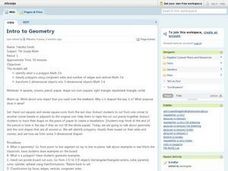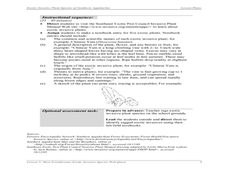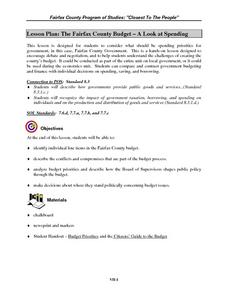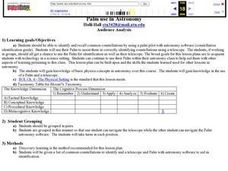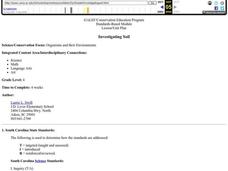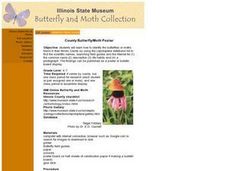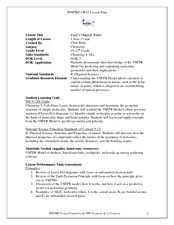Curated OER
Intro to Geometry
Seventh graders identify a polygon and classify them using congruent sides and number of edges and vertices. Students transform two dimensional objects into three dimensional objects.
Curated OER
Planet/Constellation Mobile
Pupils, through small group discussion, identify and share a rationale for shapes and patterns in the construction of a mobile that represents the solar system that makes them think of the creation of our solar system.
Curated OER
Translation
Tenth graders identify and interpret vocabulary terms as they relate to vectors. Students practice translations by creating several tessellations. Students determine the direction and distance using vectors. Students use grid paper to...
Curated OER
Most Troublesome Exotic Invasive Plant Species Web Quest
Young scholars participate in a Web Quest activity in which they identify common exotic invasive plant species of the Southern Appalachian Region. After identifying the top 10 exotic invasive species, they choose one to research in depth.
Curated OER
A Look At Spending
Students use an outdated budget to examine what the county spends its money on for its citizens. Using county information, they describe how the Board of Supervisors make budget decisions and how it can shape public policy. They also...
Curated OER
Cells, The Structural and Functional Units of Life
Students observe the general structure and organelles of plant and animal cells. Students prepare microscope slides of elodea, onion, check, and cork and identify the cells by size and shape as unicellular, multicellular, plant or animal.
Curated OER
Flying Geese
Students examine the Flying Geese quilt pattern, and discuss and identify the pattern. They write a paragraph titled, My Quilt Report, summarizing the information discussed about the quilt patterns.
Curated OER
Double Exposure Lesson Plan: Artistic Analysis of a Photograph
Students view photographs on Web module, practice answering questions of analysis, and identify artistic qualities of photographs by applying the analysis of elements of art.
Curated OER
Congruent Shapes
In this congruent shapes activity, students identify the congruent figures in sets of shapes. One example is completed. A website reference for additional activities is given.
Curated OER
Investigating Division
Students develop math sense as they multiply and divide numbers. In this algebra instructional activity, students identify the missing numbers in a multiplication and division problem. They use a calculator to help them solve the problems.
Curated OER
Palm use in Astronomy
Students identify and recall common constellations by using a palm pilot with astronomy software. Students will use their Palm to assist them in correctly identifying constellations using a telescope.
Curated OER
Planning a Healthy City
Ninth graders create a scaled model city. They create a blueprint that provides for the economic and cultural needs of a community. They identify where essential elements of the city should be located and explain the rationale for the...
Curated OER
My Farm Web
Third graders explore agriculture by viewing video clips in class. In this farm animal lesson, 3rd graders identify the animals mostly eaten that come from farms and the types of food they consume before they are eaten by us. Students...
Curated OER
Oregon Trail Landforms
Fourth graders explore landforms located along the Oregon Trail. They discuss the significance of the Oregon Trail, identify visual landforms, and explain the definition of each one. Students complete worksheets, color, and label maps.
Curated OER
Finding the Missing Letters and Sequencing
Students discover missing letters of the alphabet. In this letter recognition lesson, students identify the missing letters in a short alphabet sequence. Students complete a worksheet as an assessment.
Curated OER
Classifying Rocks
Students classify rocks into groups after they observe the rocks and identify properties that can be used to divide them into groups. They then identify other properties that could be used to classify other objects into groups.
Curated OER
Illinois County Dragonfly Poster
Learners identify the dragonflies found in their Illinois County by using the Odonata database list to find the scientific names, searching field guides and the Internet for (1) the common name (2) description (3) life habits and (4) a...
Curated OER
Investigating Soil
Fourth graders swap local soil samples with another school and examine the differences. They research soil properties, identify organisms that live in soil, create and maintain a biome of soil decomposition and design a poster to present...
Curated OER
The Cassini Robot
Young scholars compare the functions of a robot to that of the human body. In this technology lesson plan, students identify the important components of the Cassini robot that would enable it to carry out space missions. They design and...
Curated OER
County Butterfly/Moth Poster
Students discover how to identify the butterflies or moths found in their Illinois County. They use the Lepidoptera database list to find the scientific names, searching field guides and the Internet for the common name.
Curated OER
Galveston Island
Students discuss as a class how waves are formed. In groups, they participate in an experiment in which they can determine the effect of the moon on waves and discuss how Galveston Island formed over time. They identify the soil makeup...
Curated OER
Malia
Fourth graders begin their examination of the Hawaiian Islands. Using their island bookmarks from a previous lesson plan, they work together to put the information into a book. They identify the physical and human characteristics of...
Curated OER
Adjectives
In this ESL adjectives worksheet, students analyze 7 pictures that depict objects of different sizes and shapes. Students match these pictures with the adjectives that describe them.
Curated OER
Pauli's Magical Water
Students predict the shape of molecules using VSEPR theory. In this chemistry lesson, students differentiate a polar and nonpolar molecule. They discuss why water's polarity is very important.
